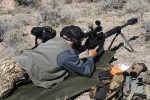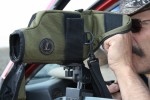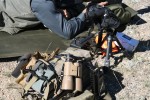 Aside from superior marksmanship, extraordinary fieldcraft and mastering tactics, one thing that sets a sniper apart is his high-quality optics.
Aside from superior marksmanship, extraordinary fieldcraft and mastering tactics, one thing that sets a sniper apart is his high-quality optics.
A sniper might have to protect his unit or entry team as they set up, or he might be assigned to take out a bad guy holding hostages. Often, he will be assigned surveillance or recon missions that require good optics.
I conducted surveillance much of the time when I was in a SWAT unit, and I relied on high-resolution spotting scopes so I could remain undetected but accurately see what was happening. If there was a rash of robberies or burglaries in an area, we would try to be in a position of advantage when the next crime occurred. Accurate observation from a distance was paramount to success.
Sniper Considerations
Selecting a spotting scope for a sniper team can be a challenge. There are as many spotting scopes on the market as there are rifles, and they range from excellent to less than useful. It’s almost impossible to find a fixed-power spotter of acceptable quality. Everybody is stuck on zoom spotters. Fixed-power spotters have fewer lenses, thereby providing more light transmission. With less glass, it’s also lighter to carry. And with simpler construction, less can go wrong with it.
Adjustable-power spotters let you adjust the power, and if the objective is large enough, you can see clearly see for great distances. Numerous companies make exceptional spotting scopes, and many are small enough to carry in a small pack.
I have a friend who was bragging about a 60-power scope of unknown make, which he claimed to be able to see a hair on a gnat’s butt. He might have bought a scope with an objective the size of the moon, but I doubt it. High-power spotters usually have a small objective and will not gather enough light to get a clear picture on the highest setting.
I like to have an objective lens at least one-half again as large as the highest magnification — or more. Better-quality glass will provide better clarity, but physics will prevail. If the power is so high the objective can’t gather enough light, it will not provide a sharp image at the highest setting. Another thing that gets in the way is mirage. It starts to goof up the operation around 25X.
 The Leupold Spotter
The Leupold Spotter
The Leupold Mark 4 Tactical is a 12-40X with a 60 mm objective. In my opinion, that’s about perfect. The 12X is low enough to focus on close stuff, and teaming the 40X eyepiece with the 60 mm objective makes for bright, clear long-range clarity. Mirage will affect the best spotting scope on high power, but the Leupold Mark 4 cuts through it better than anything else.
The other thing I like about the Leupold system is the huge eyepiece. It’s one element I always seek in a spotter. The tiny eyepieces on most scopes restrict how well I can see through them. Recently, a friend and I were checking out spotters at a big sporting-goods store. The tiny eyepieces worked well enough for average viewing, but there was a difference with the bigger eyepiece. He ended up with a Bushnell, which also had a big eyepiece. It was a great scope, through which I could see very well. However, it was quite a bit larger than the Mark 4. But my friend planned to pack it in his pickup, and it was an extremely clear, good-quality spotter.
The Mark 4 Tactical Spotting Scope also is available with mil-dot or TMR reticules, which can be matched with Leupold’s tactical binoculars and high-quality riflescopes. This is a great advantage for a sniper team — whether on duty or in competition — because everyone sees the same thing. If you are using the mil-dot or TMR slashes for hold-over, you can pick it in the binoculars or spotting scope while observing the target. The ranging operation is the same as any mil-dot scope. Another thing I really like is that Leupold built the case for the spotter, so it can be used on the tripod without taking it from the case. That goes a long way with me to help protect the spotter.
 Binoculars
Binoculars
I have always been a great fan of Leupold’s products because they make a wide range of scopes and binoculars to fit every budget. When replacing my binoculars, I again went with Leupold, mostly because good experience with its warranty. The company give its products a lifetime warranty. Of course, other manufacturers do, too, but I’ve put Leupold’s warranty to the test. I purchased a pair of 8×32 miniature binoculars about 20 years ago and really liked the clarity in such a compact piece. But recently, after dropping them, falling on them and whatever else for the past 20 years, they went out of alignment. I was impressed they lasted that long. I sent them back to be repaired and was surprised to see the company replaced them with a recent version of that binocular.
The Mark 4 Binocular is just like the spotting scope in that it has high-quality glass. The binocular is probably the most-used observation optic on a sniper team, and a pair of 10×50 glasses and a smaller pair for short recons are necessary equipment. I liked having my binos with me all the time when we were on callouts, and the quality pair of compacts did the trick. In a hide or during longer surveillances, I liked the 10x50s. At the beginning of every watch, the 10x50s were on the seat next to me.
The Mark 4 binoculars are a great match to the Mark 4 spotting scope because they can be purchased with the mil-dot or TMR reticule installed. They come with a rubberized coating that makes them sound-proof when bumped and protects them from rugged use. They are sealed tight for guaranteed moisture and fog resistance. That’s important where I live. Winter trap-line temperatures regularly hit minus 20 — and sometimes get colder. Good-quality optics are required to keep working through extreme temperature changes.
Up to the Test
I had the Mark 4 binoculars while hunting elk with friends this year. We traded binoculars, as guys do when looking for game, and the Mark 4s stood out compared to others. The other binos were high-quality competitors, but I immediately noticed the ability of the Leupolds to see in the shadows of the willows we were glassing. The clarity in shadowy spots really stood out, and one of my friends mentioned that. That could be important during surveillance or a recon stakeout when deciphering important information, such as the presence of a gun or other weapon. (Most of the surveillance or recon I did was at night, and the ability to gather light in such conditions makes or breaks a surveillance tool.)
Whether setting up optics for a sniper team or picking out glass for a competition, Leupold provides great quality and will survive the toughest mission. With long-range shooting and .50 BMG shooting becoming so popular, good glass is necessary to score targets without having to walk downrange. Most of my long-range (800 to 1,000 yards) shooting is done in the hills because I don’t have a range nearby. Leupold glass helps my wife spot for me accurately without spending excessive time going down range to check the impact.
— Dave Morelli is an all-around gun nut from Idaho.
Want to learn more about basic scope selection for your rifle? Click Here to Read the Primer

![Best Concealed Carry Guns In 2025 [Field Tested] Wilson Combat EDC X9S 1](https://gundigest.com/wp-content/uploads/Wilson-Combat-EDC-X9S-1-324x160.jpg)


![Best 9mm Carbine: Affordable PCCs [Tested] Ruger Carbine Shooting](https://gundigest.com/wp-content/uploads/Ruger-Carbine-Shooting-100x70.jpg)
![Best AR-15: Top Options Available Today [Field Tested] Harrington and Richardson PSA XM177E2 feature](https://gundigest.com/wp-content/uploads/Harrington-and-Richardson-PSA-XM177E2-feature-100x70.jpg)
